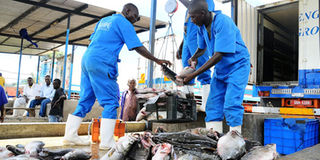Saving Uganda’s dwindling fishing sector

Fish mongers weighing fish at Katosi landing site in Mukono . There is a drastic decline in the quantities of fish from Uganda’s natural lakes. Photo By Isaac Kasamani
What you need to know:
New breed. The farming of Pangasius has seen it emerge as a commercial freshwater fish specie that is now a major component of global whitefish supplies.
Uganda’s ailing fish sector has continued to register drastic falls in production. Government policies and using Beach Management Units to control and restore the sector have not registered the desired success. With increasing populations and pressure on our fisheries resources the sector seems doomed unless certain actions are taken not with holding the increasing level of pollution as a result of human activities. There is a drastic decline in the quantities of fish from natural lakes. Statistics by the Fisheries department showed that the Nile perch stock in Lake Victoria declined from 1.9 million tons to 1.2 million between 1999 and 2001 before dropping drastically to 544,000 tons in 2005. The stocks were estimated at 370,000 tons in 2008.
Aquaculture has been fronted as the solution to the fisheries sector. According to official statistics (published by FAO), Uganda produced 76,654 tonnes of farmed fish in 2009. However, it is clear that this is a substantial over estimate based on the production capacity of existing ponds.
Pangasius
Pangasius is a farmed fish species in Asia that is out competing Nile Perch on the world market. The major farmed species in Uganda are Tilapia and African Catfish. This article fronts comparisons between Pangasius and Nile Perch, Tilapia and African catfish to show the justification for its introduction in Uganda especially as the natural factors favour its production and growth (pH 6.5-7.5 and 22-26 °C).
Since Nile Perch was introduced, the Fisheries sector experienced an unsustainable boom with the drastic declines showing that its benefits were short term. The Academy Award-nominated documentary Darwin’s Nightmare depicts the damage caused by the introduction of Nile Perch, a top-level predator in Lake Victoria. The World Conservation Union enlisted Nile Perch as one of the world’s 100 worst invasive species with countries like Australia levying high fines on anyone found in possession of live Nile Perch.
These attributes cannot be said of Pangasius. Pangasius is an omnivore and known to thrive in fish ponds and cages. It should be introduced as a farmed species and the risk of it escaping into the wild will not have drastic effects on the ecological system.. Pangasius is a seasonal breeder spawning only twice a year and would have minimal effect on the ecological system if it escapes into the wild.
In Asia, despite recommendations from government extension agencies to stock Pangasius at 20-40 fish/m2, intensive monoculture ponds are usually stocked at 40-60/m2, with some grow-out farmers stocking even higher. Yields reach 250-300 tons per hectare, exceptionally reaching 500 tons per hectare in ponds compared to Tilapia’s 10 tons and African Catfish’s 20 tons per hectare. Pangasius reaches 1.0-1.5 kg after 6 months or less, as compared to Tilapia’s 0.4 kg and African catfish’s 1.0 kg.
However, the white fillets of Pangasius are similar to Nile Perch and are on higher demand on the world market than Tilapia and African Catfish. In Asia, few grow-out farmers can be described as ‘small-scale’ because the minimum harvest from a single pond is usually 50 tonnes or more. Pangasius is also very tolerant of low quality or polluted water and can be stocked at densities as high as 120 fish per square meter.
Aquaculture introductions of Pangasius have taken place in several other Asian countries including Bangladesh, China, India, Indonesia, Malaysia and Myanmar. Viet Nam exports Pangasius to over 80 countries, including several in Europe (especially Poland and Spain), Asian countries, Mexico, Australia, the United States of America, and the Middle East. New markets such as Russia are emerging. The European Union remains the most significant market.
The farming of Pangasius has seen it emerge as a commercial freshwater species that is now a significant component of global whitefish supplies. While trade in frozen products generally stagnated in 2007 and 2008, Pangasius was the exception, with trade increasing 311 percent, traded primarily as frozen fillets.
Given the fact that fisheries is Uganda’s second highest export earner, government should make it possible for the introduction of Pangasius. All natural factors and the fish’s nature favour it’s growth and production in Uganda. A regional study on potential commercial aquaculture and fisheries projects supported by NORAD (2009) said: “Compared with the other countries reviewed in detail, Uganda has the best opportunities for shorter term commercial development and also has strong potential for regional based growth.
It also has the most directly identifiable opportunity for a major regional scale aquaculture based business potentially to be developed to a globally competitive scale.” This would save the fisheries sector and put it back on track to it’s glory days. The fact that production will be under farmed conditions will facilitate control and management of fisheries resources which has been a major government constraint. It would also further consolidate Uganda’s comparative advantage, the agricultural sector.




